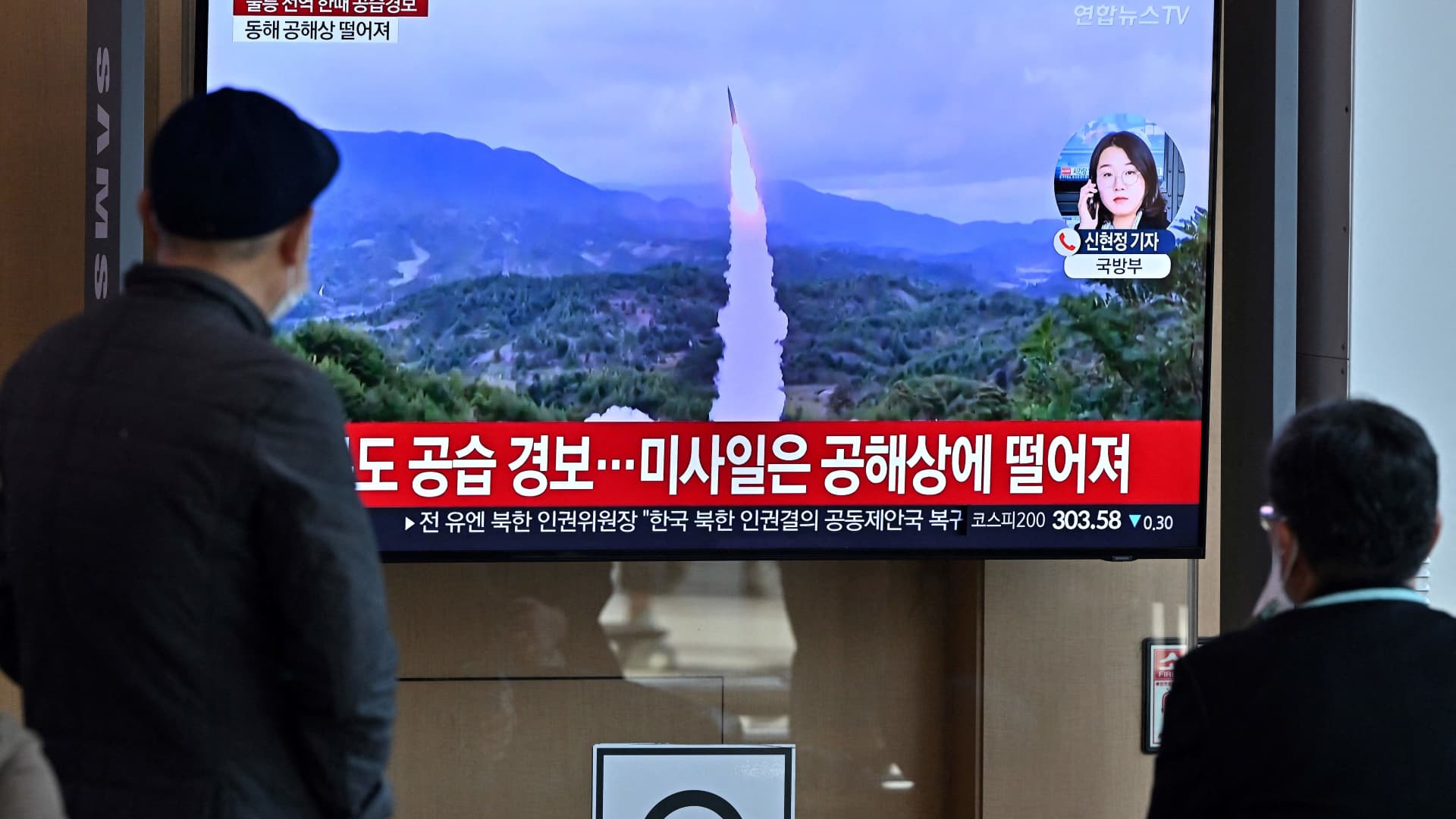People watch a television screen showing a news broadcast with file footage of a North Korean missile test, at a railway station in Seoul on November 2, 2022.
Jung Yeon-je | AFP | Getty Images
SEOUL, South Korea — North Korea fired more than 20 ballistic missiles on Wednesday, a record, sending residents of a South Korean island to underground shelters as the rivals engaged in a series of launches around their tense sea border.
North Korean leader Kim Jong Un’s military began the exchange by test-firing multiple ballistic missiles, one of which landed south of the buffer zone in the sea border between the two countries for the first time since the Korean Peninsula was divided in 1948. South Korea responded by firing three air-to-surface missiles toward the northern side of the border, which North Korea followed with 100 rounds of artillery and additional missile launches that lasted into the evening.
The exchange marked the latest significant escalation between the two neighbors after months of provocations from Pyongyang. Analysts said they were likely a sign of Kim Jong Un’s desire to ratchet up tensions as he seeks to develop his regime’s nuclear arsenal, pressure the United States to ease crippling sanctions and challenge the South’s new conservative leader.
As his repeated weapons tests make less of a splash internationally, Kim is “salami slicing the escalation ladder,” searching for new ways to grab the world’s attention, said Christopher Green, a senior consultant on the Korean Peninsula for the International Crisis Group. North Korea’s provocations on Wednesday, while highly symbolic, are “more for show than for military escalation,” he told NBC News.
‘Violation of our territory’
Hours before firing its first missiles, North Korea threatened the United States and South Korea over joint military exercises continuing this week that the North considers a rehearsal for invasion. A statement from an official close to North Korean leader Kim Jong Un suggested that if North Korea were attacked, he could use nuclear weapons to make the two countries “pay the most horrible price in history.”
The U.S. and South Korea say the drills, which returned this year after being scaled down or halted during the Trump administration, are defensive in nature and that they have no intention of attacking the North.
At an emergency meeting with top security officials, South Korean President Yoon Suk Yeol ordered that strict measures be taken in response to North Korea’s missile launches on Wednesday, which he called “effectively a violation of our territory.”
In a phone call between South Korean Foreign Minister Park Jin and Secretary of State Antony Blinken, both officials condemned the North’s incursion across the sea border, calling it “an unprecedented and grave military provocation,” according to the South Korean Foreign Ministry. They said they would thoroughly prepare for any further North Korean provocations and continue to strengthen cooperation.
The launches come as South Korea is observing a week of national mourning for victims of the Halloween crowd crush in Seoul last weekend. Yoon’s office said the timing of the North Korean launches “clearly showed the nature of the North Korean government.”
North Korea’s aggression started at 6:51 a.m. Wednesday local time (5:51 p.m. Tuesday ET), the South Korean military said, with four short-range ballistic missiles launched into the Yellow Sea from North Pyongan Province.
At 8:51 a.m., North Korea launched three short-range ballistic missiles from the eastern coastal town of Wonsan. One of those missiles landed in international waters 16 miles south of the Northern Limit Line, the de facto sea border between North and South Korea.
Lt. Gen. Shin Chul Kang, chief director of operations for South Korea’s Joint Chiefs of Staff, called it “a very irregular and unacceptable action.”
The missile’s landing site was 35 miles east of the city of Sokcho and 104 miles northwest of Ulleung island, prompting the South Korean military to raise its alert posture to Level 2 and issue an air raid alert on the island before lifting it in the afternoon. Photos published in South Korean media showed residents of the island being evacuated to underground shelters.
In response, South Korean F-15K and KF-16 fighter jets fired three precision-guided air-to-surface missiles at a target on the north side of the buffer zone of the sea border the same distance away as the North Korean missile.
“Our military’s response reaffirms our resolve to sternly respond to any North Korean provocations and shows that we are capable of accurately striking our enemy,” South Korea’s Joint Chiefs of Staff said.
Over the course of the day, North Korea fired at least 23 ballistic missiles toward the sea. It also fired 100 rounds of artillery into a maritime buffer zone between the two countries, the South Korean military said, in violation of a 2018 agreement.
No missiles landed on the actual territories of the two Koreas, and the countries did not engage in any live fire.
“Kim Jong Un is definitely testing to see what the South Koreans will do,” said Aidan Foster-Carter, an honorary senior research fellow in sociology and modern Korea at Leeds University in England. “And of course it’s very difficult, as previous South Korean leaders have found, to find any effective response which doesn’t escalate the situation further.”
North Korea has already conducted more than 50 missile launches this year, far more than ever before. U.S. and South Korean officials say North Korea may also be preparing for its seventh nuclear test, which would be its first since September 2017.
Green said North Korea’s missile launches on Wednesday were not on the same scale as the March 2010 sinking of the South Korean navy ship Cheonan, which killed 46 seamen and for which South Korea blamed the North, or the North’s November 2010 shelling of the South Korean island of Yeonpyeong, which South Korea says killed two civilians.
He pointed out that North Korea is antagonized by Yoon, a conservative leader who has vowed a tougher approach to Pyongyang, as well as the U.S.-South Korea military drills, which Russia and China have also criticized.
But Russia and China are also wary of North Korea and its unpredictability, Foster-Carter said.
“They will be telling Kim Jong Un to cool it, and for that reason I am moderately reassured that this will not escalate out of hand.”
Stella Kim reported from Seoul, and Jennifer Jett reported from Hong Kong.


























































![Mason Ramsey – Twang [Official Music Video] Mason Ramsey – Twang [Official Music Video]](https://i.ytimg.com/vi/xwe8F_AhLY0/maxresdefault.jpg)












:quality(85):upscale()/2025/01/15/049/n/1922564/a753b85967884eaf8fe5f9.34920179_.jpg)








